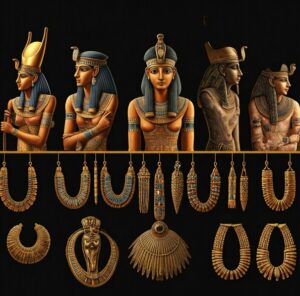Ancient Egypt’s artistic legacy is renowned worldwide, and its jewelry stands out as a symbol of beauty, craftsmanship, and cultural significance. From simple beads to elaborate gold pieces adorned with gemstones, Egyptian jewelry evolved alongside the society’s technological advancements and spiritual beliefs. Exploring the story of Egyptian jewelry offers insight into how the ancients expressed identity, status, and devotion.
Jewelry in Ancient Egyptian Society
Jewelry in ancient Egypt was more than an accessory—it held cultural, religious, and social significance. Both men and women wore jewelry, using it to signify wealth, protect against evil, and honor the gods.
-
Material Wealth: Gold, sourced from Nubia, symbolized eternal life and was favored for its durability and luster.
-
Religious Amulets: Symbols like the ankh, scarab, and Eye of Horus were believed to bring protection and good fortune.
-
Social Status: Elaborate jewelry pieces indicated the wearer’s rank in society, with pharaohs and nobles adorned in the most intricate designs.
Early Egyptian Jewelry: Simplicity and Symbolism
During the Pre-dynastic and Early Dynastic periods, jewelry was simple yet meaningful. Beads made from natural materials like shells, stones, and bones were common.
-
Key Features:
-
Handcrafted beads strung into necklaces and bracelets.
-
Use of materials such as turquoise, lapis lazuli, and carnelian for symbolic purposes.
-
-
Symbolism:
-
Early designs often represented fertility, protection, and life’s cycles.
-
The Middle Kingdom: A Shift in Craftsmanship
The Middle Kingdom (c. 2040–1780 BCE) marked a significant advancement in jewelry-making techniques and materials.
-
Goldsmithing: The use of gold became more prominent, with intricate designs showcasing remarkable craftsmanship.
-
Gemstones: Semi-precious stones like amethyst and garnet were cut and inlaid into gold settings.
-
Royal Influence: Jewelry from this period often depicted royal insignias and divine imagery.
The New Kingdom: Extravagance and Innovation
The New Kingdom (c. 1550–1070 BCE) was a golden age for Egyptian jewelry. Wealth from expanded trade routes introduced new materials and designs.
-
Luxurious Materials:
-
Imported gemstones like obsidian and faience enhanced the variety of designs.
-
Techniques like cloisonné enamel became popular.
-
-
Iconic Pieces:
-
Pectorals and broad collars adorned with symbolic motifs were worn by pharaohs and elites.
-
Tutankhamun’s tomb contained some of the most exquisite jewelry ever discovered.
-
The Ptolemaic Era: Greek Influence
During the Ptolemaic period (332–30 BCE), Greek aesthetics merged with traditional Egyptian designs, creating a unique blend of styles.
-
Features:
-
Greater use of intricate filigree work.
-
Incorporation of Greek gods alongside Egyptian deities.
-
-
Cultural Exchange:
-
Jewelry reflected the fusion of Greek and Egyptian cultures through motifs and techniques.
-
The Legacy of Egyptian Jewelry Today
Egyptian jewelry continues to inspire modern designers, with its timeless elegance and symbolic depth influencing contemporary fashion.
-
Museums and Artifacts:
-
View stunning collections at the Egyptian Museum in Cairo and the British Museum in London.
-
-
Souvenirs:
-
Travelers can purchase handmade replicas from local artisans in markets across Egypt.
-
-
Fashion Influence:
-
Jewelry inspired by Egyptian motifs remains popular worldwide, from ankhs to scarabs.
-
Why Egyptian Jewelry Matters to Modern Travelers
Understanding the evolution of Egyptian jewelry enhances your appreciation of ancient craftsmanship and its cultural importance. With Travel Joy Egypt, you can explore sites like Luxor and Cairo where these masterpieces originated, connecting with the art and traditions of a remarkable civilization.
Conclusion: A Testament to Timeless Beauty
Egyptian jewelry is a testament to the creativity, skill, and symbolic richness of ancient artisans. As you discover Egypt’s treasures, take a moment to marvel at the intricate designs and enduring beauty that continue to captivate the world.









